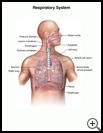
Chest Tube (Tube Thoracostomy)
What is a chest tube?
A chest tube is needed when fluid (called a pleural effusion) or air (called a pneumothorax) or blood (called a hemothorax) fills the space between the ribs and the lungs. The fluid, air, or blood puts pressure on the lungs and makes it hard to breathe. A chest tube, also called a tube thoracostomy, involves putting a tube into the space between your rib cage and one of your lungs. The tube is usually connected to a suction drain to help remove the fluid, air, or blood.
How is a chest tube placed?
Before the procedure:
- If you need a chest tube because you are having surgery inside the chest or for another non-emergency reason, your healthcare provider will ask you to sign a consent form for the procedure. This will include any other necessary treatment related to procedure. The consent form will state the reason you are having the procedure, what will happen during the procedure, and what you may expect afterward.
- If you need a chest tube because of an emergency condition, your provider may treat you without waiting for consent.
- There is risk with every treatment or procedure. Talk to your healthcare provider for complete information about whether any of these risks apply to you:
- Anesthesia problems
- Bleeding
- Blood clots
- Infection
- Tell your healthcare provider if you have any food, medicine, or other allergies such as latex.
- Tell your healthcare provider if you are taking any medicines, including nonprescription medicine, herbal remedies, or recreational or illegal drugs.
- You will have a small tube (IV catheter) inserted into a vein in your hand or arm. This will allow medicine to be given directly into your blood and to give you fluids, if needed.
During the procedure:
- You may be given a sedative through your IV to help you to relax.
- You will be given medicines to prevent pain during your surgery. These may include:
- Local anesthesia numbs the area where the chest tube will be placed.
- General anesthesia relaxes your muscles and puts you into a deep sleep. It also keeps you from remembering the operation. While you are asleep, you will have a tube in your throat to help you breath and to make sure you are getting enough oxygen. The tube may be removed before you wake up after the surgery.
- The healthcare provider will make a cut in the side of your chest between the ribs.
- The tube will be placed through the cut into the area that needs to be drained. The surgeon will secure the tube in place with stitches. The tube will be connected to a suction drain.
- The surgeon will place a dressing around the tube.
After the procedure:
- You will be checked often by nursing staff.
- There will be a dressing on skin around the chest tube. The dressing will be checked and changed by your provider or the nursing staff as needed.
- Your provider may prescribe medicine to:
- Treat pain
- Treat or prevent an infection
- Reduce swelling in or around the lungs
- Reduce fluid build-up and swelling in the body
- Help relax your airways
- Your provider may recommend other types of therapy to help relieve pain, other symptoms, or side effects of treatment.
- Your blood oxygen level will be monitored by a sensor that is attached to your finger or earlobe.
- A cardiac (heart) monitor may be used to keep track of your heart’s rate and rhythm.
- The suction drain connected to the tube will be checked and emptied regularly.
What can I do to help?
- You will need to tell your healthcare team if you have new or worsening:
- Anxiety
- Chest pain
- Chills or sweats
- Cough
- Irregular heartbeat
- Trouble breathing
- Redness, swelling, pain, warmth, or drainage from your surgical wound
- Fever, chills, or muscle aches
- Ask questions about any medicine, treatment, or information that you do not understand.
How long will I be in the hospital?
How long you stay in the hospital depends on many things, such as your general health, why you are in the hospital, and the treatment you need. Talk with your provider about how long your stay may be.
Developed by RelayHealth.
Acute Care Advisor 2016.4 published by RelayHealth.
Last modified: 2016-02-08
Last reviewed: 2016-01-19
Last modified: 2016-02-08
Last reviewed: 2016-01-19
This content is reviewed periodically and is subject to change as new health information becomes available. The information is intended to inform and educate and is not a replacement for medical evaluation, advice, diagnosis or treatment by a healthcare professional.
Copyright © 2016 RelayHealth, a division of McKesson Technologies Inc. All rights reserved.

